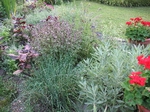How to make Winter Garden

The concept of a indoor Winter Garden (greenhouse) is fairly simple. It allows in the radiant heat from the sun, but then traps most of it in the wintergarden so that the interior stays warmer, many times much warmer, than the outside air. However, for those who are looking to install a winter garden or who are just beginning to work in one, there are many things to consider. The materials used and the way plants behave in the winter garden (greenhouse) are among those things that beginning gardeners will need to consider.
Function
The main function of a
winter garden is to provide heat and serve as a place to raise plants in an
environment where they often would not be able to survive. Often, this is the
way flowers and vegetables are raised when they would normally be out of
season. It is also a way to have plants for personal use and enjoyment.
Materials
In the past, there was only
one way to build winter garden and that involved using glass. While glass is
still an option for winter garden construction, it is often so prohibitively
expensive to the casual gardener that other materials must be used.
Polyethylene sheeting, fiberglass and other types of plastics are often common
choices for winter gardens. Plastic sheeting is the cheapest, but is also the
least durable of materials.
Location
Often, especially in the
winter, the amount of light a winter garden receives from the sun is just as
important as the heat. Maximize your winter garden’s value by making sure it is
placed in a corner of the yard that receives the most amount of direct
sunlight. Winter garden may be near buildings, but those buildings should not
block the sun from the winter garden for a significant portion of the day. Trees
are worth avoiding not only because of the shade factor, but also falling
branches could damage your greenhouse, especially if your area has violent
storms.
Size
There is a general rule
about using winter gardens: the bigger, the better. While this may be an
oversimplification, it is certainly a consideration. Winter gardens tend to
perform better and generate more heat when they are larger, because they
capture more of the sun’s rays. Building the biggest you can afford and are
capable of taking care of is a recommendation among many gardeners.
Insight
If investing in a winter garden, make sure the supporting understructure is of good quality and the
best you can afford. Some winter gardens will require bracing in the winter,
especially if you live in an area that receives a lot of snow. Snow can be very
heavy and stressful on a structure, especially if it has a high-moisture
content. Winter gardens, however, are often not built to withstand a lot of weight
on top of them.
Constructed
wetlands using species of Schoenoplectus, Triglochin and Phragmites have been
found to remove phosphorus and nitrogen from wastewaters, and that the
efficiency of removal depends on the design of the wetland, retention time and
hydraulic loading.
This
is supported by a study of Schoenoplectus validus in both horizontal and
up-flow systems, where removal of BOD, TN and TP were positively correlated
with retention time, and that the horizontal beds were more efficient at
nutrient removal than the up-flow beds.
Expectation
Remember, winter gardens are
only responsible for providing heat to an area. They cannot, by themselves,
provide light. Those who do not have artificial light sources for their plants
may find their winter gardens do not tend to grow much in the winter. This is
normal. Flower and vegetable growth may be encouraged with the use of
artificial lighting, but this adds to the operating expense of the winter garden.






